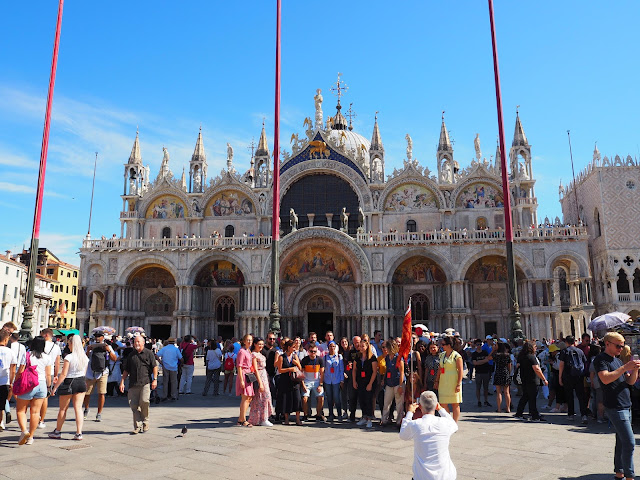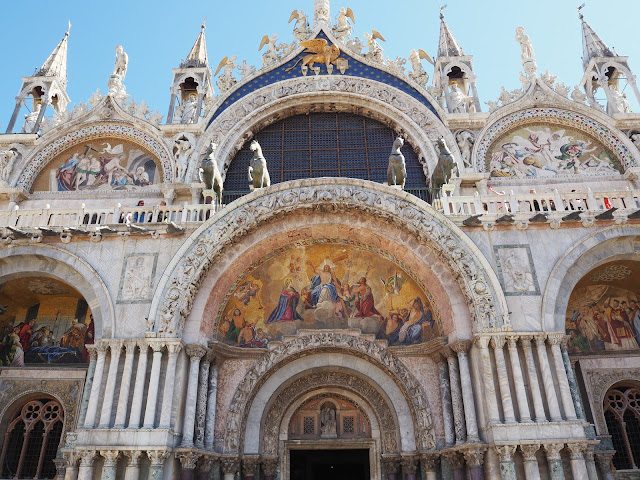【ヴェネツィア】サン・マルコ広場とサン・マルコ寺院 Venezia - Plazza San Marco & Basilica San Marco
ヴェネツィアの中心地とも言える、サン・マルコ広場へやってきた。
かつてのヴェネツィア共和国の政治と経済の中心であり、現在ではヴェネツィア観光のハイライトでもある。
多くの観光客が訪れていて、記念写真を取ったり、広場の周囲をのんびりと散策していたりしていた。
I came to Piazza San Marco, which can be said to be the center of Venice.
Once the political and economic center of the Republic of Venice, it is now a highlight of Venice tourism.
Many tourists were visiting, taking commemorative photos and taking a leisurely stroll around the square.
サン・マルコ広場の周りには、サン・マルコ寺院や時計塔、巨大な鐘楼、ドゥカーレ宮殿、国立図書館やコッレール博物館などがある。
周囲にはカフェやレストランも数多く点在していて、この広場で、ゆうに丸一日を過ごすことができるだろう。
Around Piazza San Marco, there are St. Mark's Basilica, Clock Tower, Giant Bell Tower, Doge's Palace, National Library and Correr Museum.
There are many cafes and restaurants in the area, and you can spend a whole day in this square.
中でもサン・マルコ寺院は、9世紀に建てられた建物で、ヴェネツィアを象徴する存在でもある。
828年にヴェネツィアの2人の商人が、イスラムのアッバース朝のエジプトのアレキサンドリアから聖人マルコの遺体を運んできた。その聖遺物を収める施設として建てられたのが始まりだ。
この時以来、ヴェネツィアの守護聖人は、聖マルコになった。
現在の建物は、1063年に建設が始まり、1090年ごろに完成した建物で、コンスタンチノープルから招かれた建築家の手によって、ビザンツ様式の寺院として作られた。
当時のヴェネツィアは、すでに総督を置いてその下で共和制を布いていたが、名目上はまだ東ローマ帝国の勢力下にあった。
Among them, St. Mark's Basilica is a building built in the 9th century and is also a symbol of Venice.
In 828, two Venetian merchants carried the body of Saint Marco from Alexandria, Egypt, during the Abbasid dynasty of Islam. It started as a facility to store the relics.
Since this time, the patron saint of Venice has become St. Mark.
The current building, which began construction in 1063 and was completed around 1090, was built as a Byzantine temple by an architect invited from Constantinople.
Venice at that time had already had a governor-general and republican under it, but was nominally still under the Byzantine Empire.
サン・マルコ寺院をよくよく見てみると、ヨーロッパというより、オリエンタルな雰囲気を強く感じるが、そうした背景を知ると納得できる。
寺院の正面の上部には、青銅の4頭の馬が広場を見下ろしている。この馬たちは元々はコンスタンチノープルのヒッポドロームに飾られたいた。
ヴェネツィアが1204年に第4次十字軍の際に、コンスタンチノープルを占領した際に戦利品としてヴェネツィアに持ち帰り、その勝利の象徴として、ここに飾られた。
しかしその後、ヴェネツィア共和国は1789年にナポレオンによって征服されて、その千年の歴史を終えることなる。この4頭の馬はナポレオンによって持ち去られ、パリの凱旋門に飾られた。
やがてヴェネツィアはオーストリアの一部となり、4頭の馬はヴェネツィアに返還された。
数奇な運命を辿ってきたこの4頭の馬の青銅は、現在はこのサン・マルコ寺院の内部の宝物庫の中に展示されていて、この場所にはレプリカの青銅が置かれている。
If you take a closer look at St. Mark's Basilica, you will feel a strong oriental atmosphere rather than Europe, but it is understandable to know the background.
At the top of the front of the temple, four bronze horses overlook the square. The horses were originally adorned in the Hippodrome of Constantinople.
It was brought back to Venice as a loot when Venice occupied Constantinople during the Fourth Crusade in 1204, and was displayed here as a symbol of its victory.
However, the Republic of Venice was subsequently conquered by Napoleon in 1789, ending its millennial history. The four horses were taken away by Napoleon and displayed at the Arc de Triomphe in Paris.
Eventually Venice became part of Austria and the four horses were returned to Venice.
The bronze of these four horses, which have followed a strange fate, is now on display in the treasure house inside the St. Mark's Basilica, where replica bronze is placed.
サン・マルコ寺院の内部は見学ができるが、写真撮影は許されていない。
事前に予約をしておかないと、世界中からの観光客による長い長い行列に最後に並んで、中に入るまでに長い長い時間を過ごすことになる。
内部に入ると、外観の白を基調とした明るい雰囲気からは一転して、1000年近い時間の流れを感じさせる重厚な雰囲気に圧倒される。
天井には旧約聖書の物語がモザイクで描かれていて、足元をみると、色鮮やかな大理石や宝石などで模様があちこちに見られる。
イギリスの批評家、ジョン・ラスキンは、何度もヴェネツィアを訪れていたが、1848年にも5回目の訪問を果たした。
その直前、ヴェネツィアはオーストリアに対して大規模な反乱を企ててヴェネト共和国を樹立したが、圧倒的なオーストリア軍によって鎮圧されてしまった。
荒廃したヴェネツィアの様子にショックを受けたラスキンは、1851年に『ヴェネツィアの石』を出版して、ヴェネツィアの美しい建築の数々を多くの人々に伝えた。
このサン・マルコ寺院は、ビザンチン様式からゴシック様式に建築様式が変わっていく時期の建築として紹介している。
そして、ラスキンの視点は単に芸術的な側面だけでなく、宗教的な視点で、ヴェネツィア共和国の歴史とこの寺院が人々に語る教えとの微妙な関係にも触れている。
You can see the inside of St. Mark's Basilica, but you are not allowed to take pictures.
If you don't make a reservation in advance, you'll end up in a long, long line of tourists from all over the world and spend a long, long time getting inside.
Once inside, you will be overwhelmed by the profound atmosphere that makes you feel the passage of time for nearly 1000 years, turning from the bright atmosphere based on white on the outside.
The story of the Old Testament is drawn in mosaic on the ceiling, and when you look at your feet, you can see patterns here and there with colorful marble and jewels.
British critic John Ruskin, who had visited Venice many times, made his fifth visit in 1848.
Shortly before, Venice established the Republic of Veneto in a large-scale rebellion against Austria, but was overwhelmed by the overwhelming Austrian army.
Shocked by the devastated appearance of Venice, Ruskin published The Stone of Venice in 1851, telling many about the beautiful architecture of Venice.
This St. Mark's Basilica is introduced as an architecture during the period when the architectural style changed from Byzantine style to Gothic style.
And Ruskin's point of view is not just an artistic point of view, but a religious point of view, which touches on the subtle relationship between the history of the Republic of Venice and the teachings that the temple tells people.
(Translated by Google Translate)







コメント
コメントを投稿